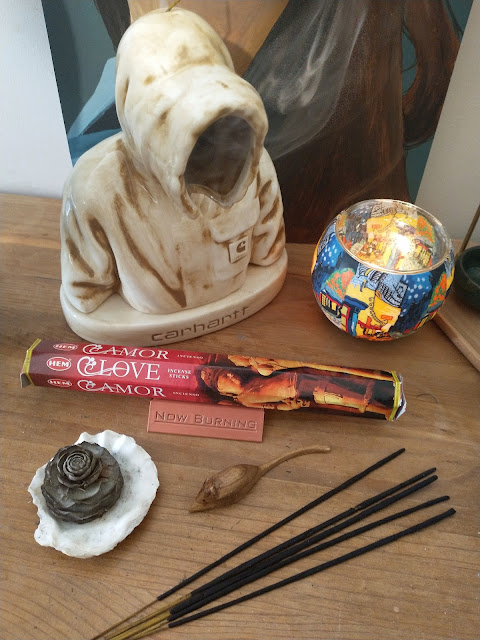I love the idea of
dhoop, as it's an older form of incense than the joss stick with a bamboo stick in the centre: it
dates from around 1900 in Mysore. Incense starts with the burning of single fragrant plants, woods, and resins such as
labdanum, agarwood, and frankincense, and then moves to blends such as the Egyptian
Kyphi and Hebrew
Ketoret, which are burnt on hot coals or charcoal, and then moves to compounds in which flammable material such as charcoal or wood is mixed with fragrant ingredients, so can be ignited by itself - hot coals or charcoal not being required. Dhoop is this compound incense, and is the incense method used through most of Asia: Tibet and Japan in particular use the dhoop method.
But though I love the idea of dhoop, I tend to only get on with thin dhoops Some of my favourite incenses have been thin dhoops, such as
Padmini,
Panchavati, and
SamsaSpoon's Swiss Pine. The thicker dhoops I find a little overbearing, both in terms of the heady nature of the fragrance, and the amount of smoke. I like a bit of heady - I like
Balaji incense, which tends to be hearty and Indian, but the headiness of Balaji tends to be in the fragrance alone; while with thick dhoop, there is the extra element of the amount of smoke, and the sheer weight of the fragrance. I believe thick dhoop is a particularly Indian form of incense - it's suitable for homes where windows are fully open, and where consumers want lots of smoke to keep away insects and lots of fragrance to cover up the bad aromas you'll get in hot countries. Thick dhoop is assertive and overwhelming.
I tend to burn incense on my desk when reviewing (normally incense in our house is burned in corners of rooms - in plant pots, or on incense holders in strategic places which are away from where anyone is sitting), but I find thick dhoops too heady for that. So they are placed - as has been this one - on the other side of my study. And that has worked - though I've had to be a little patient while waiting for the fragrance to develop around me.
Vakratund is the brand name of a fairly young incense company,
United Fragrances, who were founded in
Ahmedabad, on the upper Western coast of India, in 2011. Vakratund is one of the names of Lord Ganesh, the elephant god. Arihanta is not a scent, as I originally thought, but appears to be related to a
state of being in the Jain religion, which seems to be similar to the nirvana of Buddhism.
The dhoops are hard (there are also
wet dhoops) and covered in a green melnoorva powder. There is a vivid green scent on the stick - a little sharp and volatile. The company say they use essential oils, so I assume the volatility comes from blending it with something like
DEP, a fixative that enhances and prolongs the fragrance -
halmaddi is another such fixative. There are coconut, lime, leather, and sandalwood in the scents on the stick.
When lit there is a lot of black smoke, and strong, hungry flames. It's like burning plastic or rubber. The first few times I blew the flames out too quickly and found that the stick had only partly caught, so I had to light it again. After getting used to it, I braved the flames and smoke, and left it burning long enough to fully catch before blowing out. I like incense smoke. It is one of the joys of burning incense. There is magic, mystery, and spirituality in incense smoke. And dhoops do produce a lot of smoke. I find that very often there are two columns of smoke when burning a stick or dhoop. I don't know why there are two columns - but I find that so beautiful: the way the smoke column will split in two, and then swirl and dance, sometimes together in harmony, the swirls mirroring, and sometimes dancing apart then coming together again. And all this while the room is being filled with fragrance. Incense is awesome.
I like the scent from this dhoop. It is light, delicate, sweet, floral, like fairies whispering and dancing. There's sandalwood to ground the experience, or perhaps the sandalwood gives the florals their body and energy, like horses carrying the fairies through a forest. I have burnt a few of these dhoops, and each time I discover and enjoy more of the Arihanta fragrance. Lime, coconut, sandalwood, light florals. I don't know what oils they have used, but the combination works for me. I'm looking forward to trying more Vakratund dhoops - I bought a combo deal from
Aavyaa.com of six different scents for ₹1,240.00 (approx £12). Unfortunately Aavyaa seem to be currently out of stock of Vakratund incense (and I also notice that prices have gone up on Aavyaa - but it's still one of the best sources for the best, most interesting, and most authentic Indian incense). It's worth keeping an eye on Aavyaa to see when it comes back into stock, because this is good stuff.
Date: May 2024 Score: 45




























































































